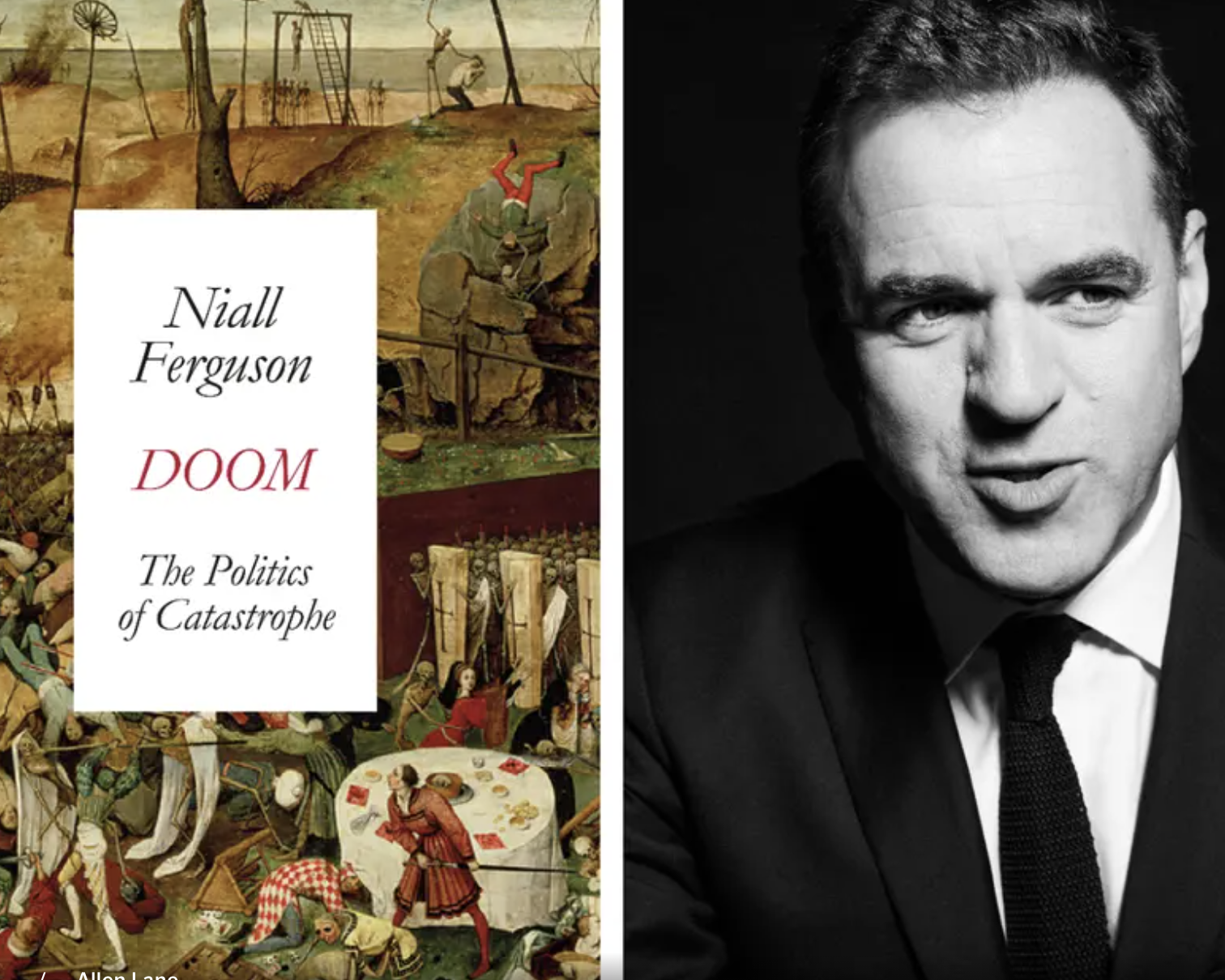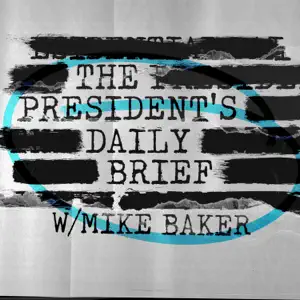
Doom: The Politics of Catastrophe by Niall Ferguson review
(Evening Standard) – From plagues and volcanic eruptions to the current Covid pandemic, mankind has always been faced with catastrophes.
Thought Leader: Niall Ferguson

This piece is by WWSG exclusive thought leader, Niall Ferguson.
I can imagine few greater responsibilities than those that weigh upon the commander of Indo-Pacific Command, Admiral Sam Paparo, whom I had the privilege of meeting last weekend, when he visited the Hoover Institution.
Paparo took over USINDOPACOM (as the Department of Defense inelegantly calls it) in May. A graduate of the Navy Fighter Weapons School, he flew F-15s on exchange with U.S. Air Force—in other words, think Top Gun. He previously commanded the 5th Fleet, headquartered in Bahrain, and the Pacific Fleet.
Despite the Italian surname, Paparo is recognizably a Scots-Irish-American whose family crossed the Atlantic to Pennsylvania just a century ago. Like those with similar heritage, he understands instinctively as well as intellectually the meaning of deterrence—and the crucial need to deter China.
With good reason, he discerns the importance to the Chinese leader of bringing the island under Beijing’s control. He also sees the enormous risks to Xi—and to the Chinese Communist Party—of launching an operation that fails.
The critical point is that the United States has got itself into a strategic jam. On the one hand—thanks to the decision of Texas Instruments not to make Maurice Chang their chief executive in the early 1980s—92% of the world’s most sophisticated semiconductors are now manufactured by the firm he founded in 1987, TSMC, on an island that the Chinese and we agree is part of “One China.” On the other hand, our commitment to the defense of Taiwan is not a treaty commitment but a somewhat ambiguously worded act of Congress.
Back in June, Paparo told the Washington Post, “[The Chinese] want to offer the world a short, sharp war so that it is a fait accompli before the world can get their act together. My job is to ensure that between now and 2027 and beyond, the U.S. military and the allies are capable of prevailing.”
“The key to thwarting Xi’s assumed strategy is a U.S. strategy called ‘Hellscape,’” Paparo said. The idea is that as soon as China’s invasion fleet begins moving across the 100-mile waterway that separates China and Taiwan, the U.S. military would deploy thousands of unmanned submarines, unmanned surface ships and aerial drones to flood the area and give Taiwanese, U.S. and partner forces time to mount a full response.
“I want to turn the Taiwan Strait into an unmanned hellscape using a number of classified capabilities,” he explained. “So that I can make their lives utterly miserable for a month, which buys me the time for the rest of everything.”
As he made clear to me when we met on Sunday, Paparo has absolutely no desire to see Hellscape actually happen. His mission is, in essence, to make it plausible enough that no Chinese leader would risk sending the People’s Liberation Army into it. The Chinese, he says, need to know the extent—though not the precise workings—of our firepower: on land, at sea, in the air, in space and on the internet. They also need to understand that we will use that firepower to thwart any bid by Beijing to take control of Taiwan.
The difficulties he faces are threefold. First, China may opt to proceed incrementally, interfering with traffic and trade in and out of Taiwan, without going to a full blockade, making it harder to justify U.S. military action. Second, there is good reason to think that China can outproduce the United States when it comes to drones and indeed most categories of military hardware. Third, there is the danger that an American administration might itself be deterred, given the catastrophic economic consequences of a U.S.-PRC showdown over Taiwan.
I was struck by how clearly Paparo has thought through the impact of a “Taiwan Semiconductor Crisis” on U.S. GDP and unemployment. The numbers he quoted are significantly worse than those for the global financial crisis. This would be closer to 1973-74, if not 1929-32. I was also struck by his aversion to Graham Allison’s book Destined for War. The whole point of Paparo’s strategy of reestablishing American deterrence is precisely to make war a low-probability disaster, not a predestined one.
An investiture is not something I ever expected to experience. It’s such an eleventh-century word. But last Tuesday I went to Windsor Castle to be formally knighted by His Royal Highness, Charles III. The ceremony was even better than I had imagined it. To kneel before the Sovereign and have my shoulders tapped by his sword was, as I blurted out, the supreme honour my life. My mother was there to see it, thank God, along with my wife and two eldest children. I suppose I can die now without too many regrets—though I shall do my utmost to postpone that melancholy event.
“The use of the Queen, in a dignified capacity, is incalculable,” wrote Walter Bagehot in his famous description of the function of the monarchy in The English Constitution. It is still true. King Charles himself is a marvel of geniality and grace. My admiration for him is boundless, for to have survived—as he did for 73 years—being the heir to the throne of the United Kingdom with his intelligence and good nature intact was no mean feat.
Even more impressive, however, is the way the royal court, from the lofty Chamberlain down to the amiable ladies in the cloakroom, contrives to make the whole throng of gong recipients feel uplifted, even on a damp December morning in a country widely regarded by most of its inhabitants as “broken,” not to mention broke.
As you proceed up the Long Walk towards the Castle—Norman in origin, Georgian in aspect—you have a sudden and thrilling reminder of what Great Britain means. The investiture plays the artful trick of making you walk through a dozen splendid rooms before you arrive at the scene of your royal rendezvous. The painting on the walls are, of course, magnificent—here a Holbein, there a Cranach—but the aggregate effect is to connect your own modest achievements to those of the long, only-once-broken line of monarchs and dynasties.
Resplendent in my Clan Ferguson kilt (as the option of “national costume” seemed much preferable to morning dress), I passed van Dyck’s splendid portrait of James I, the Scotsman who inherited the English throne. He seemed to give me a wink.
To Covent Garden on Wednesday for Tosca. Bryn Terfel was magnificent as Scarpio, despite or perhaps because of his striking resemblance to Steve Bannon.
On Thursday I attended an entertaining lunch for financial types, including City journalists, at which we were invited to make our predictions for 2025. Mine, inspired by tedious, uninformed speculation about the duration of Donald Trump’s alliance with Elon Musk: Barron Trump marries Vivian (formerly Xavier) Musk, perpetually uniting the dynasties.
Doom: The Politics of Catastrophe by Niall Ferguson review
(Evening Standard) – From plagues and volcanic eruptions to the current Covid pandemic, mankind has always been faced with catastrophes.
Thought Leader: Niall Ferguson
Michael Baker: Ukraine’s Faltering Front, Polish Sabotage Foiled, & Trump vs. Kamala
In this episode of The President’s Daily Brief with Mike Baker: We examine Russia’s ongoing push in eastern Ukraine. While Ukrainian forces continue their offensive…
Thought Leader: Mike Baker
Peter Zeihan: What Does the Future Hold for Taiwan and Semiconductors?
From Peter Zeihan: Taiwan has positioned itself as the dominant player in the semiconductor industry, but what would happen if a conflict with China broke…
Thought Leader: Peter Zeihan

